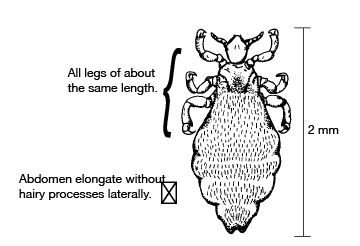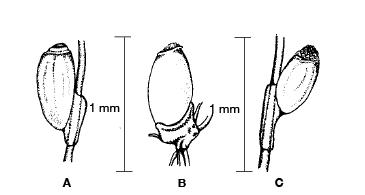Human Lice and Scabies
There are three different lice that can be found at times on humans: the head louse, the body louse, and the crab or pubic louse. These parasites can be found from the Arctic to the Tropics and they may infest anyone, rich or poor. All three species of lice are blood suckers and cause considerable skin irritation and itching when they feed or crawl on the body.
Human lice, which can establish and maintain themselves only on humans, are rarely contracted from or passed to pets or other animals. Body contact of any type can transmit lice from infested persons. Shared clothing, bedding and grooming articles can be likely culprits in spreading infestations.
Head lice and body lice are very similar in appearance. However, their habits are distinctly different. The head and body louse will reach 2 to 3 millimeters long when mature. These lice have three pairs of legs which are about equal in size, and their abdomens or rear body regions are distinctly longer than they are wide (Figure 1) . Their color will vary from dirty white to grayish-black, usually approaching the hair color of the host. Head lice almost always occur on the head, where they attach their eggs (called nits) to the hair, whereas body lice prefer to live in the clothing, from which they periodically crawl onto the skin to feed. Although body lice usually deposit their nits on clothing fibers, they sometimes deposit them on body hair as well.
Figure 1. Body louse and head louse.
Head Lice
The female head louse produces from 50 to 150 eggs, which are usually attached to hair behind the ears and on the neck and occasionally to other body hair. The incidence of infestation is greater among persons with long or dense hair, particularly when regular and thorough grooming is neglected. The eggs hatch in 5 to 10 days and the young, which resemble the adults except for size, are called nymphs. They mature in 8 to 10 days, during which they undergo three skin molts to allow for body growth. The adult head louse normally lives about three weeks or more, depending upon conditions. Both the nymphs and the adults feed on human blood. The infestation is often communicated by shared hats or other head coverings, as well as combs, brushes, towels, bedding, scarves, top coats, and sweaters. It might be noted that head lice are being seen much more frequently in school age children.
Body Lice
Infestations of body lice, which are relatively rare in the United States, are generally transmitted by contaminated clothing or bedding. Body lice survive best in conditions where clothing is not changed or washed often, and epidemic outbreaks are often associated with periods of stress such as war. Body lice females may deposit 200 or more eggs, usually attaching them to clothing fibers. The developmental period is similar to that of the head louse.
Crab Lice
Pubic lice or crab lice have become somewhat more epidemic in the United States in recent years, according to physicians’ reports. This louse is about half the size of the head or body louse and the legs are larger, with a hooked claw at the end of each leg. This gives them somewhat of a crab-like appearance and thus the name crab lice (Figure 2). These lice live almost exclusively in the pubic areas of humans. Occasionally in younger children, crab lice or other species will be found in the eyebrows.
Once established on the human host, the entire life cycle of the pubic louse is completed in about 35 days, during which time the female lays between 75 and 90 eggs. The eggs are generally cemented to the base of pubic hairs. These lice usually die within 24 hours after separation from the host. This short survival time and their sluggish movement inhibit the spread of pubic or crab lice except through intimate personal contact or in extremely crowded living and sleeping conditions, under which they can spread rapidly.
Figure 2. Crab louse.
Controlling Lice
Yellowish lice eggs (nits), about half as long as the diameter of an ordinary pin, are attached to hair or clothing by a tough ring of cement (Figure 3). Bathing or shampooing with soap and water normally does not remove nits from hair or lice attached to the body. Both lice and nits in clothing and bedding are killed, however, by thorough laundering in hot, soapy water (over 125°F for 10 minutes or longer) or by dry cleaning. Since personal items such as hats, combs, wigs, hair brushes and towels often transfer head lice infestations, they should be washed or cleaned thoroughly after each use. Clothing and bedding should be changed and washed daily. For controlling lice on the body, daily attention to personal hygiene is a must. Certain medications available as dust, lotions, ointments and shampoos are available from pharmacists or on a physician’s prescription and can be used quickly to exterminate lice and their nits on the body.
All suspected louse infestations should be reported to local health authorities or to school officials in order that the infestation sources can be located and eliminated, and a physician should be contacted for treatment. Otherwise reinfestations may occur, and the condition may spread rapidly among family members, classmates and others who are in frequent and close contact.
Figure 3. A. Head louse nit attached to hair. B. Body louse nit attached to clothing fibers. C. Crab louse nit attached to hair.
Scabies
Human scabies, which is also occasionally called seven-year itch, or just itch, is an infectious disease of the skin caused by a mite which burrows into the skin, leaving vesicles and minute burrows or tunnels that contain the mites, their eggs, and waste products of the mite. Although any part of the body can be attacked by human scabies mites, they are more commonly found in the skin between the fingers, the bend of the knee and elbow, around the belt line, thighs, and external genitalia in men and around the nipples, abdomen and lower buttocks in women. The lesions itch intensely, especially at night, and may become secondarily infected by scratching. Human scabies is generally transferred by direct contact, usually through sleeping in the same bed with an infested person and less often by contact with soiled bed clothes and under garments. Apparently newly infested persons do not experience any itching and infestations may progress extensively before being noticed. A rash often appears in about a month in the vicinity of the burrows and intense itching is felt. The itching, caused by toxic secretions and excretions, is associated directly with the burrowing.
Controlling Scabies
Human scabies infections can spread rapidly, especially under conditions of close contact such as within our school systems. The disease can be transmitted until a patient is effectively treated. It should be noted that the State Department of Education’s rules for exclusion from school require that infected children be disallowed admission to school until they are effectively treated for scabies. Effective treatment has been defined by the Oklahoma Communicable Disease Center as a regimen of two treatments separated by several days. When scabies infections are suspected, local health officials, as well as school officials, should be informed and a physician should be contacted to prescribe treatment for the infection. In general there are four essential aspects of treating scabies:
- All household members should be treated simultaneously, after bathing.
- Treatment should be applied to whole skin areas.
- All household members should be re-treated approximately one week after initial treatment, since treatment does not kill eggs.
- After treatment, patients should wear only clean clothing and all bedding should be cleaned before use.
Russell Wright
Professor Emeritus of Entomology



